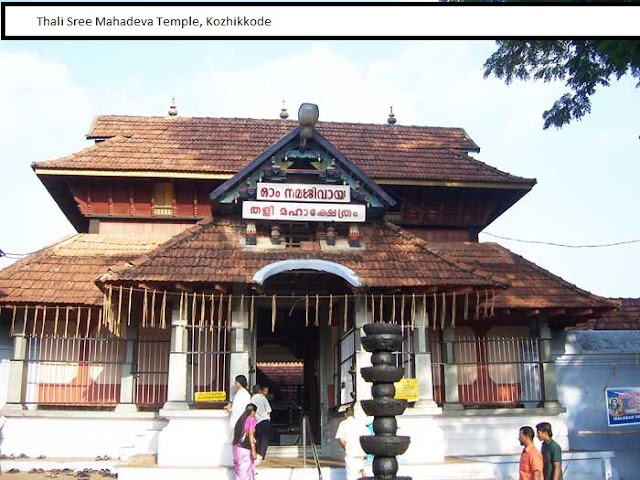The Thali Sree Mahadeva Temple under the Trusteeship of the Zamorin of Calicut, is situated in the heart of the Kozhikode Town, about three kilometers east of the Railway Station .This temple dedicated to Lord Shiva is a treasure house of historical memorabilia.
The founding and prosperity of Kozhikode town is closely linked with the benevolence of this ancient temple. It is assumed, the Jyothirlingam in the sanctum – Sanctorum of the Temple was installed towards the end of Dwaparayuga by Sri. Parasurama, who was responsible for the creation of Kerala. The deity here is worshipped in the form of of Umamaheswara. Though this divine power existed from time immemorial, the attention of the citizens of Kozhikode was (bestowed on the temple) only by about 1500 years ago. It reached its zenith during the rule of the Zamorins, who had the prestigious title Sailabdheswara (The lord of the mountain and the sea).
Temple Architecture:
The platform facing the sanctum-sanctorum, the four walls skirting the sanctum-sanctorum with the lighted lamps on all the four sides, Dwajastambam, Anakottil (flag-staff platform for elephants) the gopurams (large entrance gate), Deepasthambhum (pillars of lighting) and large outer walls are all there in the grand temple. Tali Ganapathy, Thevarathil Ganapathy, Thrumandhakunnu Bhagavathy, are all the additional deities located in the inner walls of the temple. Outside the inner wall, but within the temple premises are Lord Ayyappa in the south west. Thevarathil Bhagavathy just behind Lord Ayyappa and Naga in the west, facing in the eastern direction. In the north eastern side, just outside the Siva Temple premises, but inside the four wall of the temple, there is a separate Vishnu temple with a Dwajastambam of its own. Besides there is a small temple dedicated to Narasimha Moorthy in the southern side of the Vishnu Temple. Inside the four walls of the Sreekrishna Temple, there is also the presence of Sreevalayanad Bhagavati. So with its special architectural beauty and the presence of several Gods and Goddesses in the premises, this great temple has special significance of its own. This temple also got a special place in the cultural history of Kerala. It was here that Revathi Pattathanam, a sort of seminar on Bharatha Meemamsa, Prabhakara Meemamsa, Vedanta Meemamsa and vyakarana were conducted.
History:
Thalikkunu Shiva Temple is one of the oldest temples of Malabar. This temple has been attacked many times. Currently the Temple is under His Highness Zamorin of Calicut.Thali, Thiruvannur, Varackal, Puthur, Govindapuram etc. are other important temples in the town of Kozhikode as well as those nearby were completely destroyed as a result of Tipu's military operations. Some of them were reconstructed by the Zamorin after he returned following the defeat of Tipu Sultan in Sreerangapatanam and the Treaty of 1792.
REVATHI PATTATHANAM:
The 'Pattathanam' a festival aimed at the social-cultural enrichment of the milieu is a symbol of aristocracy surrendering to 'Divinity'. As such, it is held at the Siva temple, Thali and not in the regal glory of the Zamorins palace. Scholars were invited from the all corners of the country and were given chances to show their skills. The best among them was awarded with the title and this ceremony is known as the 'Pattathanam'.
The week-long festival is used to be held annually on the 'Revathy' day of the month of 'Thulam' (October – November), on this days the Brahmin community were mainly two-via, Cheviyannur and Kothamangalam. They took their palaces on the north and south part of the passage that lead to the Sanctum-Sanctorum of the Tali temple. The Zamorins Raja was called 'Saraswatha Nidhi' by these scholastic poets. In turn the scholastic union was known as the 'Pathinettarakavi' (18 poets and a half poet) of these the Payyur Bhattathiris – father and son, Uddhanda Shastri, Kakkasseri Bhattathiri famous and even more the 'half poet' Punam Namboodiri known so because he wrote in Malayalam. That was the golden era of the Pattathanam.
Now, on the 'Revathy' day of the month of 'Thulam' (October – November) every year, Udayasthamana Poojas conducted Lord Siva and Krishna, A scholar nominated by the Kudalloor Namboodiripad is felicitated, "Murajapa" – recitation of three Vedas is also held. A cultural seminar is held in connection with the auspicious occasion at the Zamorins College School, Tali (now The Zamorins HSS). At the closing ceremony, the 'Krishnageethi' award for the best poet and an award for temple artist are given away.





No comments:
Post a Comment